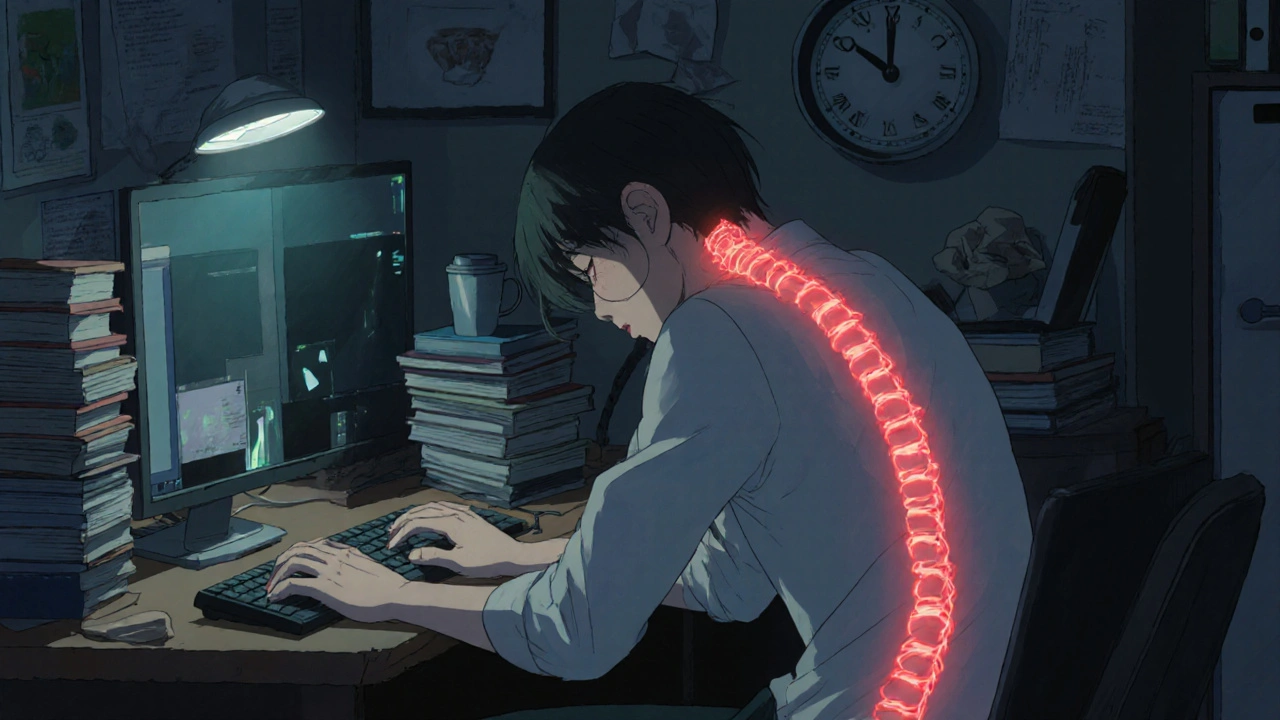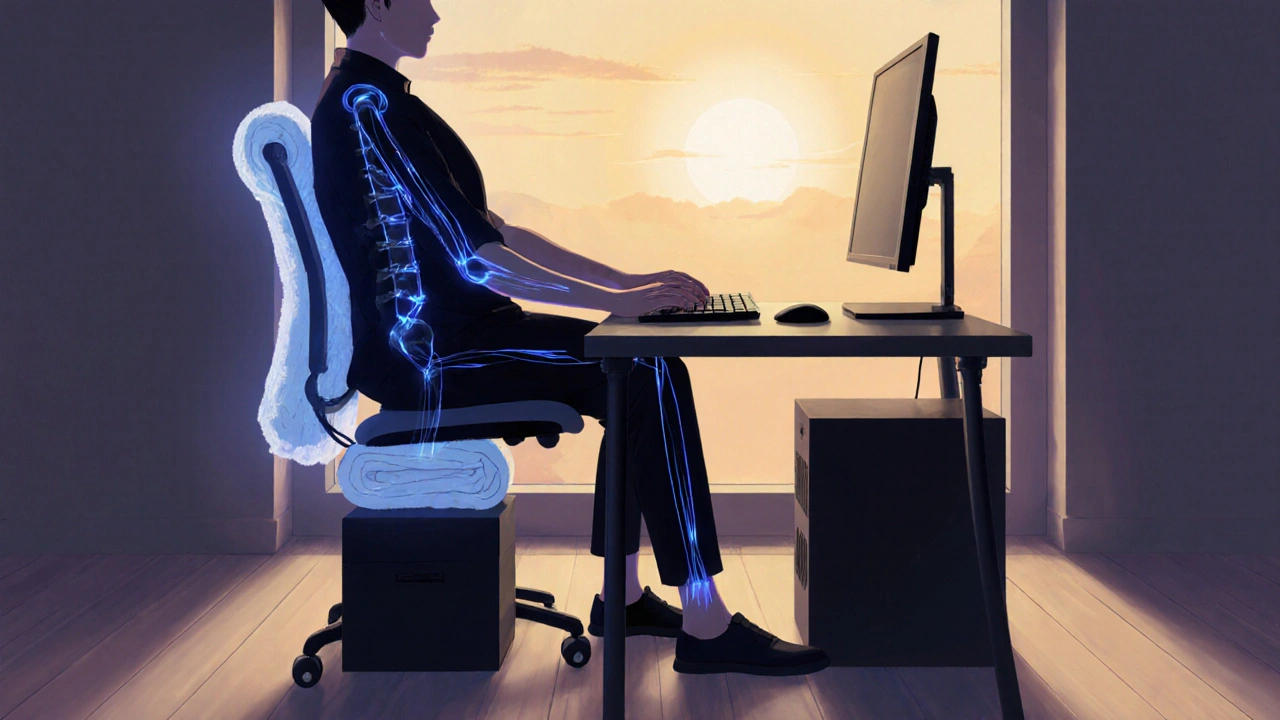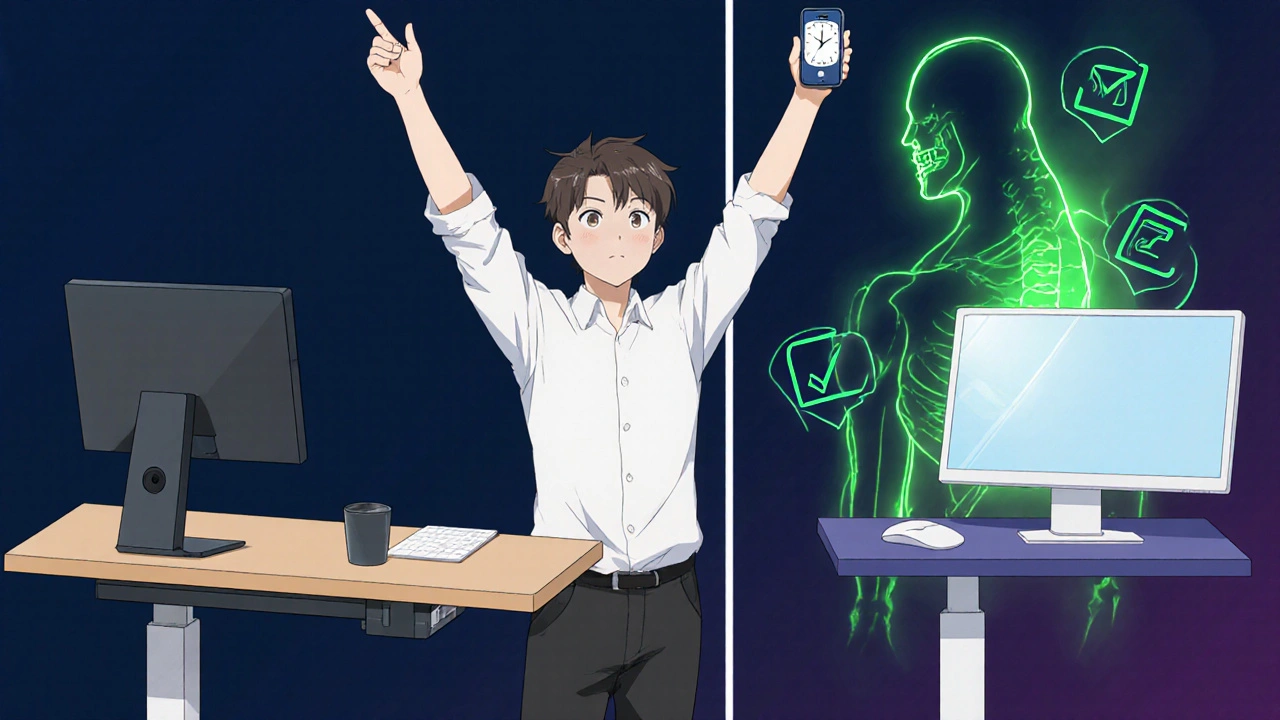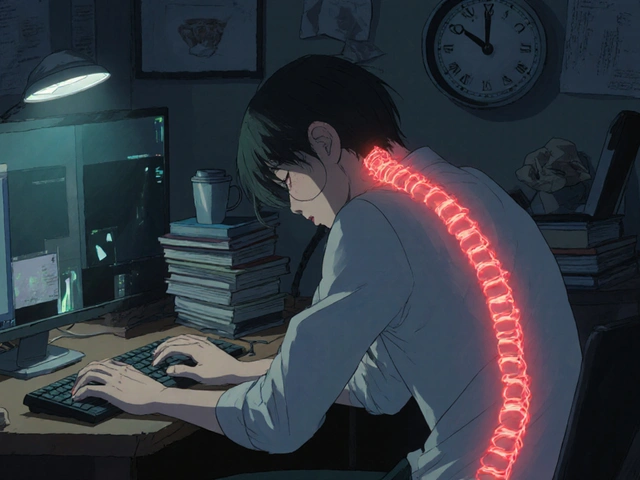
Why Your Workstation Is Hurting Your Joints
If your wrists ache after typing, your neck feels stiff by midday, or your shoulders never really relax - it’s not just "getting old." It’s your workstation. Nearly two out of every three office workers deal with work-related joint pain, and most of it comes from sitting wrong for hours on end. You don’t need expensive gear to fix this. You just need to know where to place your body - and your stuff.
The science is clear: poor posture doesn’t just make you uncomfortable. It puts pressure on your spine, squeezes nerves in your wrists, and strains muscles around your shoulders. Over time, that leads to real damage - carpal tunnel, tendonitis, even early disc degeneration. The good news? Small changes in how you set up your chair, desk, and monitor can cut joint pain by more than a third. And you don’t need to wait for your company to buy you a new chair. Most fixes cost less than $50 - or nothing at all.
How to Set Up Your Chair (Even If It’s Old)
Your chair is the foundation. If it’s wrong, everything else fails. Start with the height. Sit down and check your feet. They should rest flat on the floor, knees bent at 90 degrees. If your feet dangle, grab a stack of books, a footrest, or even a sturdy box. Don’t let your legs hang - that pulls your lower back out of alignment.
Now check your lower back. The curve in your spine shouldn’t be floating in air. Most chairs have a small knob or lever that moves the lumbar support up and down. Slide it so it fits snugly into the small of your back, right where your spine curves inward. If your chair doesn’t have adjustable lumbar support? Roll up a towel and tuck it behind your lower back. It’s not fancy, but it works.
Seat depth matters too. Sit all the way back. There should be 1 to 3 inches of space between the edge of the seat and the back of your knees. Too much space? You’ll slide forward. Too little? Your thighs get squished. Adjust the seat depth if you can. If not, use a cushion behind your back to pull you into the right position.
Where to Put Your Monitor - The #1 Mistake People Make
Here’s what most people do: they put their monitor on a stack of books so they can see it. Then they crane their neck up. That’s the fastest way to kill your neck and upper back. The top of your screen should be at or just below eye level. Not above. Not even close to above.
Try this simple test: sit back, relax your shoulders, and look straight ahead. The top edge of your monitor should line up with your eyebrows. If you have to tilt your head up to see the top of the screen, it’s too high. If you’re looking down at a 45-degree angle, it’s too low. The sweet spot? A 15- to 20-degree downward gaze. That’s about the angle you’d use to read a book in your lap.
Distance matters too. Hold your arm out. Your monitor should be about as far away as your forearm - 20 to 30 inches. If you’re squinting, move it farther. If you’re leaning in, move it closer. A monitor arm is ideal because you can tilt, raise, and swivel it with one hand. But if you’re on a budget, stack your monitor on a few books or a sturdy box. Just make sure it’s not blocking your view of your keyboard.

Keyboard and Mouse: Your Hands Are Not Designed for Flat Surfaces
Flat keyboards are a relic. They force your wrists to bend upward, squeezing the tunnel that runs through your wrist. That’s how carpal tunnel starts. The fix? Keep your wrists straight. Your elbows should rest at your sides, bent between 90 and 110 degrees. Your forearms should be parallel to the floor. If your keyboard is too high, lower your chair. If it’s too low, raise your chair - or get a keyboard tray that tilts downward (negative tilt).
Don’t reach for your mouse. It should sit right next to your keyboard - no more than 3 inches away. If you have to stretch, you’re straining your shoulder. A vertical mouse helps. It turns your hand into a handshake position, which cuts wrist strain by half. You might feel weird at first. It takes two weeks to get used to, but your wrist will thank you.
And stop typing with your fingers only. Use your whole arm. Let your shoulders stay loose. Tense shoulders = tense neck = tense head. If your shoulders creep up toward your ears, you’re working too hard. Reset them every 20 minutes.
Move Every 30 Minutes - Even If You Don’t Feel It
Stillness is the enemy of joint health. Muscles and tendons need movement to stay lubricated. Sitting for more than 30 minutes without moving increases joint pressure by 40%. You don’t need to do squats at your desk. Just stand up. Stretch your arms overhead. Roll your shoulders. Look out the window. Walk to the water cooler.
Set a timer. Every 30 minutes, take a 30- to 60-second break. Stand up. Walk for 10 steps. Do three slow neck rolls. That’s it. Research shows this cuts static loading on your joints by nearly a third. And you don’t need an app. Use your phone’s alarm. Set it for 10:00, 10:30, 11:00 - whatever works.
And if you have a sit-stand desk? Use it. Stand for 15 to 20 minutes every hour. Don’t stand all day - that’s just as bad. Alternate. Sit. Stand. Move. Your hips, knees, and lower back will feel lighter.

What Not to Buy - Budget Traps That Make Things Worse
You don’t need a $1,000 chair. But you also don’t need a $99 chair from a discount store. Here’s what to avoid:
- Chairs with no lumbar adjustment - If you can’t move the support up or down, it won’t fit your spine.
- Fixed-height desks - If you can’t raise or lower it, you’re stuck with a bad fit.
- Flat keyboards - They force your wrists into a bent position. Negative tilt is better.
- Monitor stands that don’t tilt - If you can’t angle the screen, you’ll end up looking up or down too much.
What to look for instead: chairs with 4 to 6 inches of height adjustment, lumbar support you can move, and a seat depth you can tweak. For desks, aim for 24 to 48 inches of height range. For monitors, a simple arm that lets you move the screen up, down, and forward is worth every dollar.
And skip the gimmicks. Memory foam cushions? They sink too much. Heated pads? They don’t fix posture. Focus on alignment - not comfort tricks.
Real People, Real Results
One user on Reddit spent eight years with lower back pain. Then he got a chair with proper lumbar support. Within six weeks, his pain dropped from a 7 out of 10 to a 2. Another person switched to a vertical mouse after wrist numbness started. Two weeks later, the tingling was gone. A remote worker in Minnesota used a stack of books to raise her monitor - and suddenly, her headaches stopped.
These aren’t miracles. They’re corrections. You’re not broken. Your setup is just out of sync with your body.
And the data backs it up. People who follow these simple rules report 38% less pain in their wrists and shoulders. Productivity goes up. Sick days go down. The return on investment? Over $4 for every $1 spent on better ergonomics.
Where to Start Today
You don’t need to fix everything at once. Pick one thing. Right now. Here’s your 10-minute plan:
- Adjust your chair height so your feet are flat and knees are at 90 degrees.
- Move your monitor so the top is at eye level - or just below.
- Put your mouse right next to your keyboard - no reaching.
- Set a timer for 30 minutes. When it goes off, stand up and stretch for one minute.
Do that for five days. Then check in. How does your neck feel? Your wrists? Your lower back?
If you feel better - you’re on the right track. If not, adjust one more thing. Maybe your chair is too deep. Maybe your monitor is still too high. Keep tweaking. Your body will tell you what’s right.
Joint pain isn’t something you just have to live with. It’s a signal. Listen to it. Fix the setup. Move more. And give your body the space it needs to work - not fight - against you.



I tried the towel-for-lumbar trick last week and my back hasn't felt this good in years. No joke. I was skeptical but now I carry a folded towel in my bag everywhere. It's like a tiny hug for my spine.
Monitor at eye level. Not above. Not below. Exactly at eye level.
You people spend too much time fiddling with chairs and towels. Just get up and walk. That’s all you need. No $50 fixes. No gadgets. Just move. You’re not a robot.
This isn't ergonomics. This is a cry for help from a generation that forgot how to sit in a chair without a 12-point ergonomic manifesto. We used to work 14-hour days on wooden stools and still lived to 80. Now we need a $300 chair to not cry when we bend over.
I use a stack of old textbooks under my monitor. Looks like a DIY art project but my neck hasn't killed me since. Also, the vertical mouse? Took me 3 weeks to stop feeling like I was holding a handshake with a stranger. Now I can't go back.
I love how this post doesn't sell you a product. Just tells you to adjust what you already have. So many people think they need to buy their way to comfort. But really, it's just about listening to your body. And setting a stupid phone alarm. That part's free.
ok so i tried the towel thing and honestly at first i thought it was gonna be dumb but like... it actually works? my lower back stopped screaming at 3pm. also i got a $12 keyboard tray off amazon and now my wrists dont feel like theyre being crushed by a vise. i still type like a caveman but at least i dont cry anymore lol
The monitor at eye level changed everything for me I used to have these terrible headaches and I didn’t even connect it to my setup until I read this now I just look straight ahead and my brain feels calmer
In India, many of us still work on dining tables or beds. But even here, the principles hold. A pillow behind the lower back, a book under the monitor, and a 2-minute stretch every half hour - these are not luxuries. They are basic human necessities. Thank you for reminding us that ergonomics is not about wealth, but awareness.
You claim 38% less pain. But where's the control group? Who measured this? Did you account for placebo effect? Or is this just another wellness influencer’s anecdotal data dressed up as science? The towel trick is charming. But it’s not evidence.
I'm the guy who bought the $99 'ergonomic' chair from Amazon. It came with a built-in speaker and a vibrating massage feature. I still use it. But now I also have a towel behind my back and a $3 footrest. The chair just makes me feel like I'm in a spaceship. The towel? That's what actually saved me.